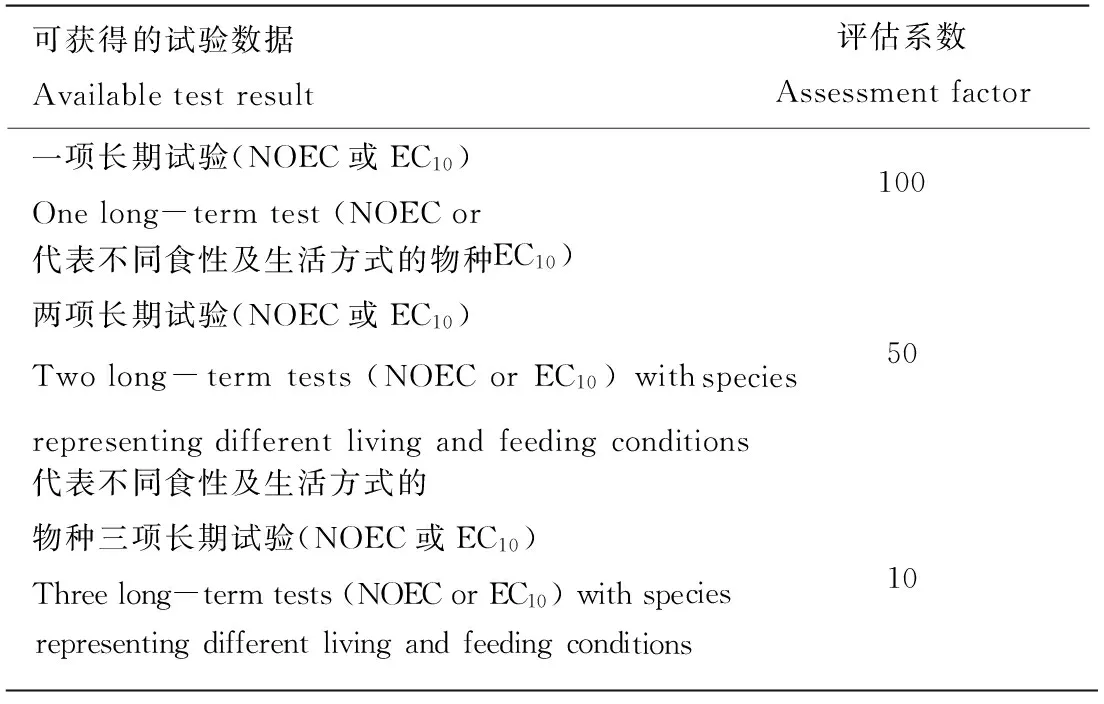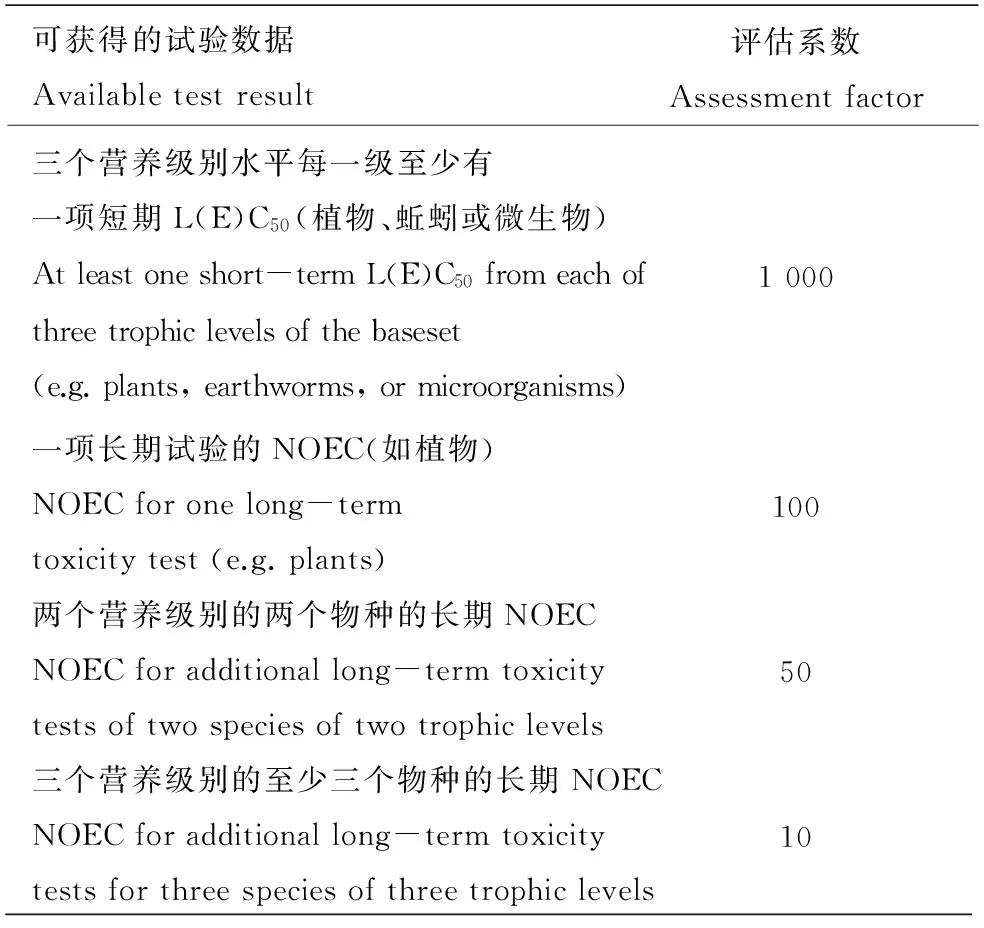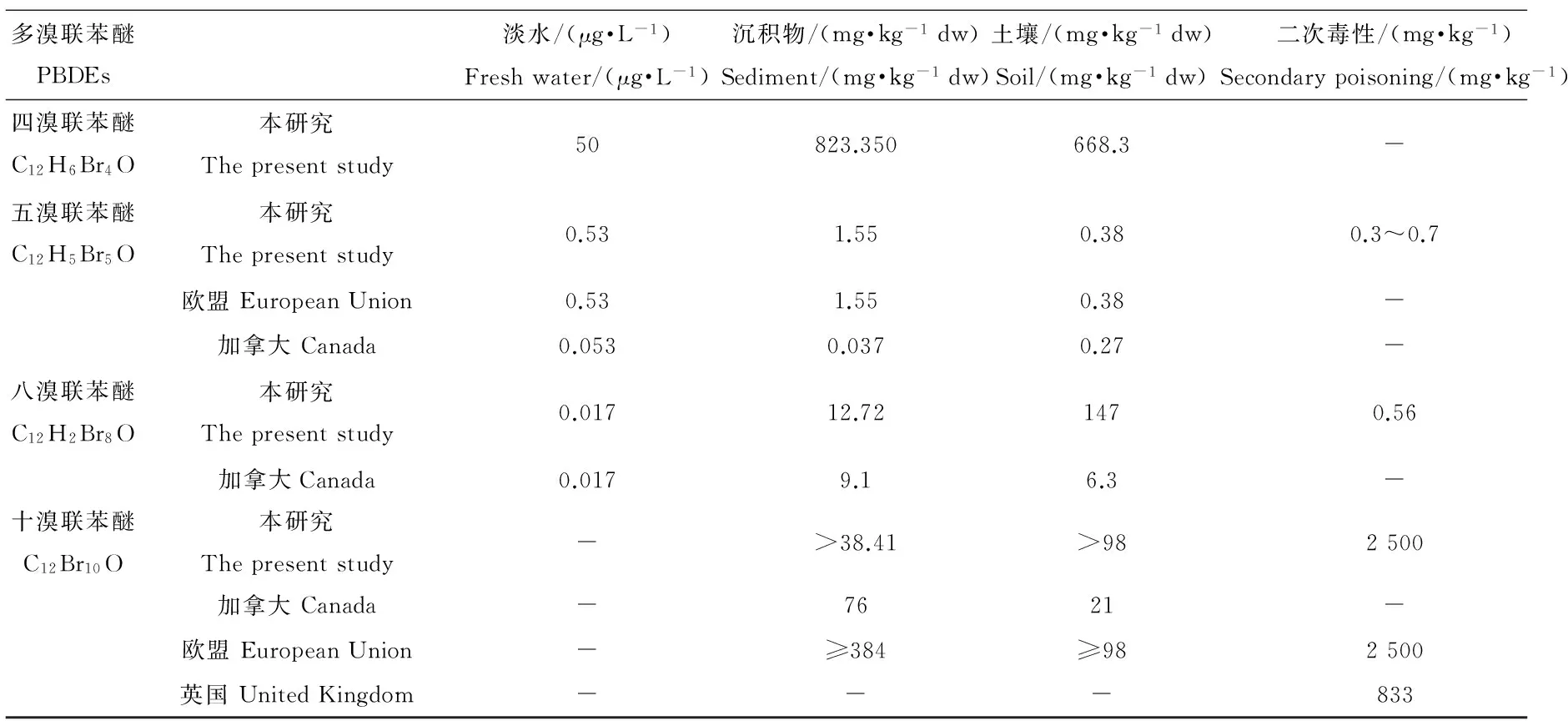基于我国物种毒性数据的多溴联苯醚预测无效应浓度分析
曹莹,朱岩,张亚辉,*,李霁,王飞飞
1. 中国环境科学研究院 环境基准与风险评估国家重点实验室 国家环境保护化学品生态效应与风险评估重点实验室,北京 100012 2. 桂林理工大学环境科学与工程学院,桂林 541004
基于我国物种毒性数据的多溴联苯醚预测无效应浓度分析
曹莹1,朱岩2,张亚辉1,*,李霁1,王飞飞2
1. 中国环境科学研究院 环境基准与风险评估国家重点实验室 国家环境保护化学品生态效应与风险评估重点实验室,北京 100012 2. 桂林理工大学环境科学与工程学院,桂林 541004
采用多溴联苯醚(PBDEs)对我国广泛分布生物物种的生态毒性数据,根据欧盟现有化学物质风险评价技术指导文件,对不同环境介质中PBDEs预测无效应浓度(PNEC)进行了推导。结果表明:我国淡水环境PBDEs(四溴、五溴、八溴)的PNEC水分别为50 μg·L-1、0.53 μg·L-1、0.017 μg·L-1。沉积物环境PBDEs(四溴、五溴、八溴和十溴)的PNEC沉积物分别为823.35 mg·kg-1wt、1.55 mg·kg-1dw、12.72 mg·kg-1dw、>38.41 mg·kg-1dw。土壤环境PBDEs(四溴、五溴、八溴和十溴)的PNEC土壤分别为668.3 mg·kg-1wt、0.38 mg·kg-1dw、147 mg·kg-1dw、>98 mg·kg-1dw。次生毒性PBDEs(五溴、八溴和十溴)的PNEC经口分别为0.3~0.7 mg·kg-1、0.56 mg·kg-1、2 500 mg·kg-1。该数值期为我国PBDEs的环境风险评价提供科学基础。
多溴联苯醚;预测无效应浓度;淡水;沉积物;土壤;本土物种
Received 27 November 2015 accepted 31 May 2016
多溴联苯醚(PBDEs)是在20世纪70—80年代开始大量生产和使用的溴化阻燃剂,它们在家用电器、计算机、泡沫塑料和布料等产品的成分比例可达5%~30%[1]。由于它在环境中具有持久性,同时也能在环境中远距离迁移,容易在生物体内发生生物累积,因此PBDEs被认定为持久性有机污染物(POPs)。2009年12月30日,美国环保署(EPA)发布了针对邻苯二甲酸酯、短链氯化石蜡、多溴联苯醚(PBDEs)和全氟化学品(包括全氟辛酸铵)这4类化学品在内的首个“化学品行动计划”,并将对这4类化学物质引起的健康和环境问题予以处理。
世界各国和组织如欧盟[2]和加拿大[3]对五溴联苯醚、八溴联苯醚及十溴联苯醚进行了毒害评估或环境风险评估,英国[4]也对十溴联苯醚进行了生态风险评价。目前,我国对PBDEs的研究主要集中在典型区域如珠三角区域以及电子垃圾拆解地,主要PBDEs的环境分布[5-6]、污染特征[7-8]、环境行为[9]及人体暴露[10-13]等。仅有少量研究[14-16]采用国外预测无效应浓度(PNEC)值对环境中PBDEs进行风险评估,可能对我国本土生物产生“欠保护”或“过保护”作用。目前,采用我国广泛分布生物物种的生态毒性数据推导多溴联苯醚在环境介质中PNEC值尚未见报道。本研究采用欧盟现有的化学物质风险评价技术指导文件(TGD)[17]中计算PNEC方法,广泛搜集筛选PBDE对我国生物的毒性数据,对我国淡水环境、沉积物环境、土壤环境以及二次毒性的PNEC值进行推导,旨在为开展我国多溴联苯醚的生态风险评估提供基础。
1 数据与方法(Data and methods)
1.1 毒性数据筛选
PBDEs的毒性数据从已发表的文献和美国环境保护署的EPA ECOTOX数据库(http://cfpub.epa.gov/ecotox/)获取相关物质对我国广泛分布物种的急性/慢性毒性数据。依据欧盟适用于现有化学物质的风险评价技术指南(TGD)中筛选数据原则,水生环境部分受试生物物种应至少涵盖生态系统的3个营养级(如藻类、甲壳类、鱼类)。陆生环境部分筛选出以蚯蚓为代表的慢性数据。原则上选择我国已有的生物种,包括外来引进物种如虹鳟鱼等,舍弃国外物种如黑头呆鱼等。
1.2 PNEC推导方法
1.2.1 淡水
根据获得的试验数据,淡水水生生态系统PNEC的推导方法主要有评估系数法和统计外推法。就物种实验室数据而言,如果可获得至少含有至少8个不同生物类别的10个无观测效应浓度(NOEC)(最好超过15个),则可以采用统计外推法(物种敏感度分步法,SSD)计算PNEC。而评估系数是依据得到生物类别短期和长期试验数据的多少来选择。评估系数见表1。

表1 淡水环境PNEC水评估系数[17]

表2 淡水沉积物PNEC沉积物的评估系数[17]

表3 陆生环境PNEC土壤的评估系数[17]

表4 次生毒性PNEC经口评估系数[17]
1.2.2 沉积物
沉积物主要是由于化学物质吸附于颗粒物后沉降作用造成的污染源。由于缺少生活于沉积物中生物的资料,因此PNEC沉积物一般采用平衡分配法进行计算。公式(1)如下:
(1)
PNEC水,水中的预测无效应浓度(mg·L-1);RHO悬浮物,悬浮物的湿体积密度(kg·m-3);K悬浮物—水,悬浮物水分配系数(m3·m-3);PNEC沉积物,沉积物中的预测无效应浓度(mg·kg-1)。
如果可以获得底栖生物—沉积物长期试验,可以通过最低NOEC或者EC10除以评估系数得到PNEC沉积物。评估系数见下表2。
1.2.3 土壤
陆生环境部分考虑直接通过渗透水或土壤暴露对土壤中生物的效应。由于进行生态毒理学试验的土壤特征(有机质、粘土成分、土壤pH值以及土壤湿度)各有所不同,来自不同实验数据不可比,因此要将结果转化为标准土壤数据。大部分土壤中生物毒性效应数据(蚯蚓、植物、微生物和跳虫)有限,一般采用平衡分配法计算PNEC土壤。公式(2)如下:
(2)
其中,RHO土壤,土壤的湿体积密度(kg·m-3);K土壤-水,土壤水分配系数(m3·m-3);PNEC土壤,土壤的预测无效应浓度(mg·kg-1)。
如果能够得到土壤中生物毒性数据,则可以通过最低NOEC或者L(E)C50除以评估系数得到PNEC土壤。评估系数见下表3。
1.2.4 次生毒性
次生毒性是具有生物富集和生物蓄积作用的亲脂性化学物质,通过长期暴露对食物链中较高营养级别的生物产生的直接或间接毒性效应。次生毒性的浓度-效应的评估结果一般以预测无效应浓度(PNEC经口)表示。公式(3)和表4如下:
PNEC经口=TOX经口/AF经口
(3)
其中,PNEC经口为鸟类或哺乳动物次生毒性PNEC(kg·kg-1);AF经口为外推PNEC经口的评估系数;TOX经口为LC50,鸟或NOEC鸟或NOEC哺乳动物,食物,慢性(kg·kg-1)。

表5 多溴联苯醚急性和慢性数据
2 结果(Results)
根据毒性数据筛选原则,对四溴联苯醚(CAS NO.: 5436-43-1)、五溴联苯醚、八溴联苯醚和十溴联苯醚(CAS NO.: 1163-19-5)的急、慢性数据收集整理(见表5)。
2.1 淡水水体PNEC水
四溴联苯醚对水生生物的急性数据包括藻、溞、鱼和虾共13个。慢性毒性数据包括藻和溞共2个毒性数据(NOEC),其中大菱鲆48 h和96 h NOEC值非长期试验的NOEC数据,选择评估因子50计算PNEC水。藻和溞的NOEC数值最低为等鞭金藻3 d生长抑制率2.53 mg·L-1,得到PNEC水为50 μg·L-1。
五溴联苯醚对水生生物的急性数据包括藻(等鞭金藻和羊角月牙藻)、溞(大型溞)、鱼(青鱂、虹鳟和大菱鲆)共9个。同时藻、溞、鱼3个基础营养级别的长期慢性数据(NOEC)共9个,并且最低NOEC值是大型溞21 d繁殖率5.3 μg·L-1,选择评估因子10得到PNEC水为0.53 μg·L-1。
八溴联苯醚对水生生物毒性数据只有大型溞21 d慢性试验,在暴露浓度大于1.7 μg·L-1下,以大型溞的存活率、繁殖率和生长率为毒性终点时均没有产生影响效果,大型溞的21 d NOEC >1.7 μg·L-1,选择评估系数为100,得到八溴联苯醚的淡水环境中的PNEC水>0.017 μg·L-1。
十溴联苯醚对水生生物急性毒性数据包括鱼类和溞类。但在其最大溶解度下水生生物均无影响,因此基于目前可获得的的十溴联苯醚的淡水水生生物毒性数据不能够推导出其淡水环境中PNEC水。
2.2 淡水沉积物PNEC沉积物
四溴联苯醚对沉积物毒性数据无法获得,采用平衡分配法计算沉积物环境中的PNEC沉积物。采用文献[2]报道的有机碳-水分配系数Koc为757 450 L·kg-1,按照TGD中标准环境特征参数,忽略四溴联苯醚在水体悬浮物与气体的分配,计算得到K悬浮物-水=18 937.15 m3·m-3,RHO悬浮物采用TGD默认值1 150 kg·m-3,PNEC沉积物为823.35 mg·kg-1wt。

表6 PBDEs淡水水体的PNEC值

表7 PBDEs淡水沉积物PNEC值
五溴联苯醚对淡水沉积物慢性毒性数据包括绿勾虾、摇蚊昆虫和夹杂带丝蚓共3个。3种代表不同食性以及生活方式最低的NOEC值是3.1 mg·kg-1dw(28 d夹带蚓NOEC),选择评估系数10,得到PNEC沉积物=0.31 mg·kg-1dw。换成标准沉积物环境NOEC值(15.5 mg·kg-1dw),得到PNEC沉积物(标准)=1.55 mg·kg-1dw。
八溴联苯醚对淡水沉积物的长期慢性数据只有夹杂带丝蚓,在大于1 272 mg·kg-1dw的沉积物浓度下没有对它产生影响。评估系数选用100,得到十溴联苯醚的PNEC沉积物>12.72 mg·kg-1dw。
十溴联苯醚对沉积物长期慢性数据包括夹杂带丝蚓,在大于3 841 mg·kg-1dw的沉积物浓度下没有对夹杂带丝蚓产生影响。评估系数选用100,得到十溴联苯醚的PNEC沉积物>38.41 mg·kg-1dw。
2.3 土壤PNEC土壤
四溴联苯醚对土壤环境毒性数据无法获得,采用平衡分配法计算土壤环境中的PNEC值。BDE-47的有机碳-水分配系数KOC为757 450 L·kg-1,BDE-47固-水分配系数KP土壤为15 149 L·kg-1,RHO土壤采用TGD默认值1 700 kg·m-3,土壤-水分配系数K土壤-水为22 723.7 m3·m-3,四溴联苯醚PNEC土壤为668.3 mg·kg-1wt。
五溴联苯醚对土壤生物慢性数据包括6个植物3个毒性终点的NOEC值,其中玉米的21 d苗重NOEC值16 mg·kg-1dw为最低值。采用评估因子50,得到PNEC土壤=0.32 mg·kg-1dw。由于土壤生物利用率以及毒性效应与土壤性质有关,不同类型土壤数据不能相比较,一次将实验结果转化为标准土壤数据。采用OECD试验标准,默认有机质含量2.9%(Fom土壤(试验)),将NOEC值(16 mg·kg-1)转化为标准土壤数据NOEC(标准)为18.8 mg·kg-1,得到PNEC土壤(标准)为0.38 mg·kg-1dw。
八溴联苯醚的陆生毒性数据赤子爱胜蚓分别在28 d和56 d的死亡率和繁殖率长期慢性毒性试验中发现其在大于1 470 mg·kg-1dw浓度下都没有产生影响。评估系数选用100,得到八溴联苯醚的PNEC沉积物为>147 mg·kg-1dw。
十溴联苯醚的陆生毒性数据包括植物和蚯蚓。6种植物在大于5 349 mg·kg-1dw浓度下没有产生影响,赤子爱胜蚓在大于4 910 mg·kg-1dw浓度下也没有产生影响。评估系数选用50,得到十溴联苯醚的PNEC沉积物为>98 mg·kg-1dw。
2.4 PNEC经口
对于化学物质暴露于水环境中,其生物浓缩因子BCF≥100或生物放大因子BMF>1,通过水(水生生物)-鱼-食鱼鸟类或哺乳动物的传递途径对食物链产生富集或蓄积效应,则需要对物质通过食物链的暴露进行次生毒性评估。
文献中查到五溴联苯醚的鱼类生物富集因子BCF=14 350 L·kg-1,需要进行五溴联苯醚的次生毒性评估[2]。基于哺乳动物(老鼠)的毒性数据,五溴联苯醚反复的剂量暴露最主要的影响表现在老鼠肝脏中,并且在30 d的老鼠慢性研究中测定NOAEL值为1 mg·kg-1是最敏感的毒性终点,将其乘以转换系数10~20,得到老鼠的NOEC值为10~20 mg·kg-1。选择哺乳动物毒性数据的外推评估系数30,因此得到五溴联苯醚的PNEC经口为0.3~0.7 mg·kg-1。
虽然从可获得的信息可以推断出十溴联苯醚潜在的生物浓缩和生物蓄积效应较低。然而在食肉鸟的蛋、鱼类和哺乳动物体内发现了十溴联苯醚,这说明它们还是可以从环境中吸收。从可获得的哺乳动物毒性数据可以推导出十溴联苯醚的次生毒性的PNEC经口为2 500 mg·kg-1。但是,据报道十溴联苯醚对新生小鼠的行为抑制浓度(18.3~167 mg·kg-1)要远低于PNEC经口(2 500 mg·kg-1)[33]。

表8 PBDEs土壤PNEC值
依据文献八溴联苯醚的BCF值为16 390 L·kg-1,需要进行次生毒性评估[2]。哺乳动物(兔子)28 d经口毒性试验[42],每天的灌胃计量分别为0、2.0、5.0和15 mg·kg-1得到母体和胎儿的NOAEL值均为5.0 mg·kg-1。用其推导八溴联苯醚次生毒性的预测无效应浓度PNEC经口。将其乘以转换系数33.3,得到兔子的NOEC值为166.5 mg·kg-1。选择哺乳动物毒性数据的外推评估系数300,因此得到八溴联苯醚的PNEC经口值为0.56 mg·kg-1。
3 讨论(Discussion)
4种PBDEs对不同介质中的PNEC值见表9。在推导五溴联苯醚的PNEC水时,欧盟[2]采用大型溞的慢性毒性数据,获得水体的PNEC水为0.53 μg·L-1,与本研究推导一致。加拿大[3]采用也是21 d大型溞NOEC值5.3 μg·L-1,但评估因子选择100,得到ENEV水体为0.053 μg·L-1。在推导PNEC沉积物时,本研究与欧盟推导一致,而加拿大[3]是选择成年夹杂带丝蚓[28]28 d慢性数据除以评估因子100,得到ENEV沉积物为0.037 mg·kg-1dw。
针对八溴联苯醚,加拿大[3]采用淡水环境中21 d以生存率、繁殖率和生长率为终点的大型溞[38]慢性毒性数据NOEC 1.7 μg·L-1除以评估因子100,得到ENEV水体为0.017 μg·L-1,与本研究推导值一致。沉积物环境中基于成年夹杂带丝蚓28 d的慢性毒性数据除以应用因子100,得到ENEV沉积物为9.1 mg·kg-1dw。土壤环境中赤子爱胜蚓56 d基于死亡率和繁殖率的慢性毒性终点的NOEC值除以应用因子100,得到ENEV土壤值为6.3 mg·kg-1dw。
在推导十溴联苯醚的PNEC值时,均无法获得淡水环境中毒性数据,不能得到PNEC水。加拿大沉积物采用成年夹杂带丝蚓28 d的慢性毒性数据除以应用因子100,得到ENEV沉积物为76 mg·kg-1dw[3]。对于土壤赤子爱胜蚓28 d和56 d死亡率和繁殖率NOEC值除以评估因子100,得到ENEV陆生值为21 mg·kg-1dw。欧盟2003年的十溴联苯醚风险评估报告中采用夹杂带丝蚓大于3 841 mg·kg-1dw的慢性毒性数据,得到PNEC沉积物≥384 mg·kg-1dw[48]。对于陆生环境,6种植物和蚯蚓分别在大于5 349 mg·kg-1dw和大于4 910 mg·kg-1dw的暴露浓度下均没有毒性效应,除以评估因子50,可以得到PNEC土壤≥98 mg·kg-1dw。
对于十溴联苯醚的二次毒性,通过可获得的哺乳动物毒性数据可以推算出PNEC经口为2 500 mg·kg-1,与本研究一致。英国[33]在2009年的十溴联苯醚的环境风险评估报告中指出,十溴联苯醚对Nitocra spinipes(美丽猛水蚤属)的毒性已经通过Breitholtz等[35]证实。据瑞典标准程序[43]开展试验,这些浓度对Nitocra spinipes的生存无影响(96 h LC50>100 mg·L-1)。报告还指出了十溴二苯醚的二次毒性,基于一项长期毒性试验得到的NOAEL值(1 120 mg·kg-1)和评估因子30得到十溴二苯醚的PNEC经口值为833 mg·kg-1[44-45]。虽然可以获得新的哺乳动物的毒性试验数据但是其NOAEL值还无法给出,因此需要等到整个毒性数据完善后对十溴二苯醚的二次毒性PNEC经口值进行修订。

表9 环境中PBDEs的预测无效应浓度(PNEC)
目前我国对PBDEs物质的大多数研究报道的数据为环境介质、生物体及人体的暴露数据,而对PBDEs的风险评估的报道很少,且尚未有该类物质的我国环境阈值的研究。本研究广泛搜集筛选PBDEs对我国广泛分布生物物种的生态毒性数据,推导了4种PBDEs物质在不同环境介质中PNEC值,为我国PBDEs物质的风险评估提供支持。另外,由于PBEDs物质的生态毒性数据较少,在目前的数据量上采用评估因子法计算PNEC值是合适的。由于评估因子法是基于专家经验判断的方法,虽然该方法要求数据量少,计算过程简单,有学者指出该方法计算环境阈值的不确定性很高[46]。因此,需要进一步积累更多的PBDEs对我国生物的生态毒性数据尤其是慢性毒性数据,为PBDEs类物质推导环境阈值及风险评价提供数据基础。
[1] Martin M, Lam P K, Richardson B J. An asian quandary: Where have all of the PBDEs gone? [J] Marine Pollution Bulletin, 2004, 49(5): 375-382
[2] European Union. European union risk assessment report: Diphenyl ether, pentabromo derivative (pentabromodiphenyl ether) [R]. European Commission, 2001
[3] Environment Canada. Canadian Environmental Protection Act. Ecological screening assessment report on polybrominated diphenyl ethers (PBDEs) [R]. Environment Canada, 2006
[4] European Commission. Bis(pentabromophenyl) ether: Summary risk assessment report [R]. Ispra, Italy: Institute for Health and Consumer Protection, European Chemicals Bureau, 2003
[5] Ueno D, Kajiwara N, Tanaka H, et al. Global pollution monitoring of polybrominated diphenyl ethers using skipjack tuna as a bioindicator [J]. Environmental Science & Technology, 2004, 38(8): 2312-2316
[6] 刘汉霞, 张庆华, 江桂斌, 等. 多溴联苯醚及其环境问题[J]. 化学进展, 2005, 17(3): 554-562
Liu H X, Zhang Q H, Jiang G B, et al. Polybrominated diphenyl ethers and its related environmental problems [J]. Progrss in Chemistry, 2005, 17(3): 554-562 (in Chinese)
[7] 陈社军, 麦碧娴, 曾永平, 等. 珠江三角洲及南海北部海域表层沉积物中多溴联苯醚的分布特征[J]. 环境科学学报, 2005, 25(9): 1265-1271
Chen S J, Mai B X, Zeng Y P, et al. Polybrominated diphenyl ethers (PBDEs) in surficial sediments of the Pearl River Delta and adjacent South China Sea [J]. Acta Scientiae Circumstantiae, 2005, 25(9): 1265 -1271 (in Chinese)
[8] 向彩红, 罗孝俊, 余梅, 等. 珠江河口水生生物中多溴联苯醚的分布[J]. 环境科学, 2006, 27(9): 1732-1737
Xiang C H, Luo X J, Yu M, et al. Distribution of polybrominated diphenyl ethers in aquatic species from the Pearl River Estuary [J]. Environmental Science, 2006, 27(9): 1732-1737 (in Chinese)
[9] 邹梦遥, 龚剑, 冉勇. 珠江三角洲流域土壤多溴联苯醚(PBDEs)的分布及环境行为[J]. 生态环境学报, 2009, 18(1): 122-127
Zou M Y, Gong J, Ran Y. The distribution and the environmental fate of polybrominated diphenyl ethers in watershed soils of Pearl River Delta [J]. Ecology and Environment Sciences, 2009, 18(1): 122-127 (in Chinese)
[10] Guruge K S, Taniyasu S, Yamashita N, et al. Perfluorinated organic compounds in human blood serum and seminal plasma: A study of urban and rural tea worker populations inSri Lanka [J]. Journal of Environmental Monitoring, 2005, 7(4): 371-377
[11] Qu W, Bi X, Sheng G, et al. Exposure to polybrominated diphenyl ethers among workers at an electronic waste dismantling region in Guangdong, China [J]. Environment International, 2007, 33(8): 1029-1034
[12] Yeung L W, So M, Jiang G, et al. Perfluorooctanesulfonate and related fluorochemicals in human blood samples from China [J]. Environmental Science & Technology, 2006, 40(3): 715-720
[13] 王亚韡, 江桂斌. 人体中多溴联苯醚(PBDEs)和全氟辛烷磺酰基化合物(PFOS)研究进展[J]. 科学通报, 2008, 53(2): 129-140
[14] 陈宣宇, 薛南冬, 张石磊, 等. 废旧电器拆解区河流沉积物中多溴联苯醚(PBDEs)的污染特征与生态风险[J].环境科学, 2014, 35(10): 3731-3739
Chen X Y, Xue N D, Zhang S L, et al. Pollution characteristics and ecological risk of polybrominated diphenyl ethers (PBDEs) in river sediments from an electrical equipment dismantling area [J]. Enivironmental Science, 2014, 35(10): 3731-3739 (in Chinese)
[15] 赵恒, 孟祥周, 向楠, 等. 上海市受纳污水河流中多溴联苯醚的生态风险评价[J]. 环境化学, 2012, 31(5): 573-578
Zhao H, Meng X Z, Xiang N, et al. Ecological risk assessment of polybrominated diphenyl ethers in river receiving wastewater in Shanghai [J]. Enivironmental Chemistry, 2012, 31(5): 573-578 (in Chinese)
[16] 张璐璐, 刘静玲, 张少伟, 等. 基于aquatox模型的白洋淀湖区多溴联苯醚(PBDEs)的生态效应阈值与生态风险评价研究[J]. 生态毒理学报, 2014, 9(6): 1156-1172
Zhang L L, Liu J L, Zhang S W, et al. AQUATOX model for ecological threshold and ecosystem risk assessment of polybrominated diphenyl ethers (PBDEs) in Baiyangdian Lake ecosystems [J]. Asian Journal of Ecotoxicology, 2014, 9(6): 1156-1172 (in Chinese)
[17] European Chemical Bureau. Technical guidance document on risk assessment in support of commission directive 93/67/EEC on risk assessment for new notified substances, commission regulation (EC) No 1488/94 on risk assessment for existing substances, and directive 98/8/EC of the European parliament and of the council concerning the placing of biocidal products on the market [R]. Office for Official Publications of the European Communities, 2003
[18] 范灿鹏. BDE-47及电子垃圾拆卸区土壤底泥浸出液对水生生物的毒性效应[D]. 广州: 暨南大学, 2011
Fan C P. Toxic effects of BDE-47 and the lixivium of soil and sediment from electronic waste recycling site to aquatic organsims [D]. Guangzhou: Jinan University, 2011 ( in Chinese)
[19] 李卓娜, 孟范平, 赵顺顺, 等. 2,2',4,4'-四溴联苯醚(BDE-47)对4种海洋微藻的急性毒性[J]. 生态毒理学报, 2009, 4(3): 435-439
Li Z N, Meng F P, Zhao S S, et al. Acute toxic effects of 2,2',4,4'-tetrabromodiphenyl ether (BDE-47) on four marine microalgae [J]. Asian Journal of Ecotoxicology, 2009, 4(3): 435-439 (in Chinese)
[20] EMEP. New substances: Model assessment of potential for long-range transboundary atmospheric transport and persistence of pentabde [R]. EMEP contribution to the preparatory work for the review of the CLRTAP protocol on POPs, 2004
[21] Davies R, Zou E. Polybrominated diphenyl ethers disrupt molting in neonatal Daphnia magna [J]. Ecotoxicology, 2012, 21(5): 1371-1380
[22] Mhadhbi L, Fumega J, Boumaiza M,et al. Acute toxicity of polybrominated diphenyl ethers (PBDEs) for turbot (Psetta maxima) early life stages (ELS) [J]. Environmental Science and Pollution Research, 2012, 19(3): 708-717
[23] Key P B, Chung K W, Hoguet J, et al. Toxicity and physiological effects of brominated flame retardant BDE-47 on two life stages of grass shrimp, Palaemonetes pugio [J]. Science of the Total Environment, 2008, 399(1): 28-32
[24] Mhadhbi L, Fumega J, Beiras R. Toxicological effects of three polybromodiphenyl ethers (BDE-47, BDE-99 and BDE-154) on growth of marine algae Isochrysis galbana [J]. Water, Air, & Soil Pollution, 2012, 223(7): 4007-4016
[25] CMABFRIP (Chemical Manufacturers Association Brominated Flame Retardant Industry Panel). Pentabromodiphenyl oxide (PeBDPO): A 96-hour toxicity test with the freshwater alga (Selenastrum capricornutum) [R]. Wildlife International Ltd. Project Number 439a-105, 1997
[26] CMABFRIP (Chemical Manufacturers Association Brominated Flame Retardant Industry Panel). Pentabromodiphenyl oxide (PeBDPO): A 48-hour flow-through acute toxicity test with Daphnia magna [R]. Wildlife International Ltd. Project Number: 439a-106, 1997
[27] CMABFRIP (Chemical Manufacturers Association Brominated Flame Retardant Industry Panel). Pentabromodiphenyl oxide (PeBDPO): A flow-through life-cycle toxicity test with the cladoceran (Daphnia magna) [R]. Wildlife International Ltd. Project Number: 439a-109, 1998
[28] GreatLakes Chemical Corporation. Pentabromodiphenyl oxide (PeBDPO): A prolonged sediment toxicity test with lumbriculus variegatus using spiked sediment [R]. Wildlife International Ltd. Project No. 298a-109, 2000
[29] GreatLakes Chemical Corporation. Pentabromodiphenyl oxide (PeBDPO): A prolonged sediment toxicity test with Hyalella azteca using spiked sediment [R]. Wildlife International Ltd. Project Number: 298a-111, 2000
[30] GreatLakes Chemical Corporation. Pentabromodiphenyl oxide (PeBDPO): A prolonged sediment toxicity test with Chironomus riparius [R]. Wildlife International Ltd., 2000
[31] Great Lakes Chemical Corporation. Pentabromodiphenyl oxide (PeBDPO): A prolonged sediment toxicity test with Lumbriculus variegatus using spiked sediment [R]. Wildlife International Ltd. Project Number: 298a-109, 2000
[32] Great Lakes Chemical Corporation. Pentabromodiphenyl oxide (PeBDPO): A toxicity test to determine the effects of the test substance on seedling emergence of six species of plants [R]. Wildlife International Ltd. Project Number: 298-102, 2000
[33] Brooke D N, Burns J, Crookes M J, et al. Environmental risk evaluation report: Decabromodiphenyl ether [R]. Environment Agency, 2009
[34] 张泽光. 水环境中十溴联苯醚的生物富集特性及生物毒性研究[D]. 上海: 东华大学, 2013
Zhang Z G. Studies on the bioconcentration characteristics and biological toxicity of decabromodiphenyl ether in the water environment [D]. Shanghai: Donghua University, 2013 (in Chinese)
[35] Breitholtz M, Nyholm J R, Karlsson J, et al. Are individual NOEC levels safe for mixtures? A study on mixture toxicity of brominated flame-retardants in the copepod Nitocra spinipes [J]. Chemosphere, 2008, 72(9): 1242-1249
[36] Ciparis S, Hale R C. Bioavailability of polybrominated diphenyl ether flame retardants in biosolids and spiked sediment to the aquatic oligochaete,Lumbriculus variegatus [J]. Environmental Toxicology and Chemistry, 2005, 24(4): 916-925
[37] Xie X, Qian Y, Wu Y, et al. Effects of decabromodiphenyl ether (BDE-209) on the avoidance response, survival, growth and reproduction of earthworms (Eisenia fetida) [J]. Ecotoxicology and Environmental Safety, 2013, 90: 21-27
[38] CMABFRIP (Chemical Manufacturers Association Brominated Flame Retardant Industry Panel). Octabromodiphenyl oxide (OBDPO): A flow-through life-cycle toxicity test with the cladoceran (Daphnia magna) [R]. Wildlife International Ltd., 1997
[39] GreatLakes Chemical Corporation. Effect of octabromodiphenyl oxide on the survival and reproduction of the earthworm, Eisenia fetida [R]. Wildlife International Ltd., 2001
[40] GreatLakes Chemical Corporation. Octabromodiphenyl ether: A prolonged sediment toxicity test with Lumbriculus variegatus using spiked sediment with 2% total organic carbon [R]. Wildlife International Ltd., 2001
[41] GreatLakes Chemical Corporation. Octabromodiphenyl ether: A prolonged sediment toxicity test with Lumbriculus variegatus using spiked sediment with 5% total organic carbon [R]. Wildlife International Ltd., 2001
[42] Breslin W, Kirk H, Zimmer M. Teratogenic evaluation of a polybromodiphenyl oxide mixture in New Zealand white rabbits following oral exposure [J]. Fundamental and Applied Toxicology, 1989, 12(1): 151-157
[43] SIS. Determination of acute lethal toxicity of chemical substances and effluents to Nitocra spinipes boeck-static procedure [S]. Swedish Standard, 1991
[44] ECB. European union risk assessment report: Bis(pentabromophenyl ether) [R]. European Chemicals Bureau, Institute of Health and Consumer Protection, European Commission, 2002
[45] ECB. Update of the risk assessment of bis(pentabromophenyl) ether [R]. European Chemicals Bureau, Institute of Health and Consumer Protection, European Commission, 2007
[46] 冯承莲, 汪浩, 王颖, 等. 基于不同毒性终点的双酚A(BPA)预测无效应浓度(PNEC)研究[J]. 生态毒理学报, 2015, 10(1): 119-129
Feng C L, Wang H, Wang Y, et al. Predicted no effect concentration of Bisphenol A (BPA) based on different toxicological endpoints[J]. Asian Journal of Ecotoxicology, 2015, 10(1): 119-129 (in Chinese)
◆
Analysis of Predicted No-effect Concentrations for Polybrominated Diphenyl Ethers (PBDEs) Based on the Toxicity Data of Species in China
Cao Ying1, Zhu Yan2, Zhang Yahui1,*, Li Ji1, Wang Feifei2
1. State Key Laboratory for Environmental Criteria and Risk Assessment, State Environmental Protection Key Laboratory of Ecological Effects and Risk Assessment of Chemicals, Chinese Research Academy of Environmental Science, Beijing 100012, China 2. College of Environmental Science and Engineering, Guilin University of Technology, Guilin 541004, China
According to the EU technical guidance document on risk assesssment, the predicted no-effect concentration (PNEC) values of four kinds of polybrominated diphenyl ethers (PBDEs) in the environmental mediums were derived with the ecotoxicity data of our widely distributed species in China. The results showed that the PNECwaterof PBDEs (tetrabromobiphenyl ether, pentabromodiphenyl ether, octabromobiphenyl ether) in the freshwater were 50 μg·L-1, 0.53 μg·L-1, 0.017 μg·L-1, respetively. The PNECsedimentof PBDEs (tetrabromobiphenyl ether, pentabromodiphenyl ether, octabromobiphenyl ether, decabromobiphenyl ether) in the sediment were 823.35 mg·kg-1wt, 1.55 mg·kg-1dw, 12.72 mg·kg-1dw, >38.41 mg·kg-1dw, respetively. The PNECsoilof PBDEs (tetrabromobiphenyl ether, pentabromodiphenyl ether, octabromobiphenyl ether, decabromobiphenyl ether) in soil were 668.3 mg·kg-1wt, 0.38 mg·kg-1dw, 147 mg·kg-1dw, >98 mg·kg-1dw, respetively. The PNECoralof PBDEs (pentabromodiphenyl ether, octabromobiphenyl ether, decabromobiphenyl ether) of secondary poison were 0.3~0.7 mg·kg-1, 0.56 mg·kg-1, 2 500 mg·kg-1, respetively. These values could provide the scientific basis for the environmental risk assessment of PBDEs in China.
PBDEs; the predicted no-effect concentration (PNEC); freshwater; sediment; soil; native species
10.7524/AJE.1673-5897.20151127005
国家水体污染控制与治理科技重大专项(2012ZX07501003);科技基础性专项(2014FY120606)
曹莹(1983-),女,工程师,研究方向为环境生态风险评估,E-mail: caoyingyeah@sina.com
*通讯作者(Corresponding author), E-mail: zhangyahui@craes.org.cn
2015-11-27 录用日期:2016-05-31
1673-5897(2016)2-609-11
X171.5
A
简介:张亚辉(1979—),女,环境科学博士,副研究员,主要研究方向环境毒理学,发表学术论文20余篇。
曹莹, 朱岩, 张亚辉, 等. 基于我国物种毒性数据的多溴联苯醚预测无效应浓度分析[J]. 生态毒理学报,2016, 11(2): 609-619
Cao Y, Zhu Y, Zhang Y H, et al. Analysis of predicted no-effect concentrations for polybrominated diphenyl ethers (PBDEs) based on the toxicity data of species in China [J]. Asian Journal of Ecotoxicology, 2016, 11(2): 609-619 (in Chinese)

